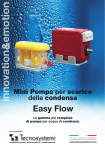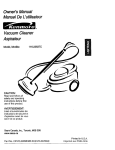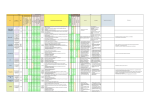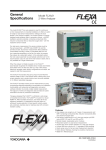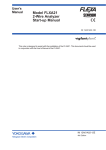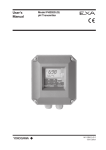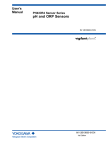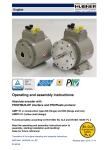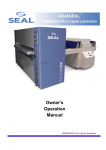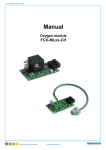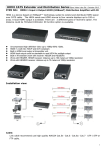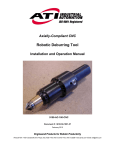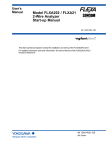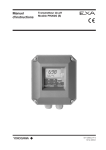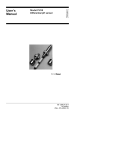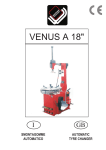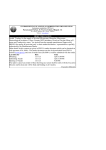Download User`s Manual
Transcript
User’s Manual YOKOGAWA Model FC20 Cleaning Systems IM 12B6V1-01E-E 5th 4th edition edition 2 TABLE OF CONTENTS 1. INTRODUCTION ............................................................................................................3 1-1. General...................................................................................................................3 1-2. Cleaning system .....................................................................................................3 1-3. Selection criteria .....................................................................................................3 1-4. Compatibility...........................................................................................................4 1-5. Warranty and service..............................................................................................4 2. SPECIFICATIONS ..........................................................................................................5 2-1. Brush cleaning .......................................................................................................5 2-2. Chemical cleaning ..................................................................................................6 2-3. Models and suffix codes.........................................................................................6 3. DESCRIPTION ...............................................................................................................7 3-1. Brush cleaning system ...........................................................................................7 3-1-1. General ...............................................................................................................7 3-1-2. Driving mechanism (electric) ................................................................................7 3-1-3. Driving mechanism (pneumatic ..........................................................................7 4. INSTALLATION ..............................................................................................................8 4-1. Unpacking and checking ........................................................................................8 4-2. Installation site........................................................................................................8 4-3. Brush cleaning .......................................................................................................9 4-3-1. Brush holder .......................................................................................................9 4-3-2. Driving mechanism (electric) ................................................................................9 4-3-3. Wiring the driving mechanism (electric)...............................................................10 4-3-4. Driving mechanism (pneumatic)..........................................................................10 4-3-5. Control unit for driving mechanism (pneumatic) ..................................................10 4-3-6. Connecting control and driving mechanism (pneumatic) .....................................11 4-4. Chemical cleaning ..................................................................................................11 4-4-1. Spray unit............................................................................................................11 4-4-2. Connecting the spray unit ...................................................................................11 5. ADJUSTMENTS ...........................................................................................................12 5-1. Brush cleaning .....................................................................................................12 5-1-1. Brush adjustments ............................................................................................12 5-1-2. Driving mechanism (pneumatic).........................................................................12 6. DIMENSIONS ...............................................................................................................13 6-1. Spare parts list .....................................................................................................15 7. INSTALLATION OF CHEMICAL CLEANING SYSTEMS HCN 2/3/4/F .....................16 IM 12B6V1-01E-E 3 1. INTRODUCTION 1-1. General For industrial applications and particularly for automatic process measurements, it is of the greatest importance that the sensitive part of a glass electrode and the flow diaphragm of a reference electrode are kept clean. Often it is not practical to interrupt a process for cleaning the electrodes, an accurate indication is required over a long period, replacing the electrodes is difficult, etc. There, an automatic cleaning mechanism may be the solution. YOKOGAWA manufactures two different cleaning systems for pH and/or ORP (Redox) measurements: - chemical cleaning - brush cleaning a. pneumatically driven b. electrically driven CONTROL UNIT TUBING PISTON UNIT O-rings (11x3) O-RINGS BRUSH HOLDER K1547PP (spare tubing, EPDM) Fig. 1 Brush Cleaning (pneumatical driven) Fig. 2 Brush Cleaning (electral driven) 1-2. Cleaning systems The cleaning elements have standardised dimensions for mounting in flow and/or Model FF20-P43 FF20-F43 FF20-S43 FD20-P47 FD20-F47 FD20-S47 FS20-V42 FS20-S43 Type Flow fitting Flow fitting Flow fitting Immersion fitting Immersion fitting Immersion fitting Subassembly flow fitting Subassembly flow fitting immersion fittings. These fittings have the following model codes: Material Polypropylene Polyvinylidene fluoride Stainless steel Polypropylene Polyvinylidene fluoride Stainless steel PVC Stainless steel Detailed specifications of the fittings are on separate sheets (see GS 12B6K1 and GS 12B6K2) IM12B6V1-01E-E 4 1-3. Selection criteria The table below indicates the recommended cleaning method for your specific application. Selection criteria Applications with: Oils, fats Resins (wood, pulp) Emulsions of latex Fibers (paper, textile) Crystalline precipations (carbonates) Amorpheus precipations (hydroxides) Mechanical Brush Chemical Acid Base X X X X XX X XX 1-4. Compatibility The Yokogawa analysers model number PH402 and PH450 is equipped with a wash timer function to control the chemical cleaning system. Detailed information is given on sheet and GS 12B6B3-E-E (PH402) and GS 12B6B5-E-E (PH450). 1-5. Warranty and service Products and parts are warranted to be free from defects in workmanship and material under normal use and service for a period of typically twelve months from the date of shipment by manufacturer. The sales organisation has the possibility to deviate from this typical warranty period and the actual terms and conditions as specified in the sales order must be consulted. Damages, caused by wear and tear, inadequate maintenance, corrosion and attack by chemical processes are excluded from this warranty coverage. Any defective goods need to be sent to the service of the sales organisation for repair or replacement and the returned material should be accompanied by a letter of transmittal, which should include the following information: 1. Part number, model code and serial number 2. Date and number of sales order IM 12B6V1-01E-E 3. Length of time of service and type of service 4. Description of the faulty operation of the device and the circumstances of the failure 5. Pressure, temperature, process compensation and all other process conditions or environmental circumstances which are related to the installation and possibly failure of the device 6. Statement as to whether warranty or non-warranty service is requested 7. Complete shipping and billing instructions for return of material and name, phone number of contact person that can be approached for further information. The returned goods that have been in contact with process fluids must be detoxified and disinfected prior to shipment for the health and safety of our employees. Material Safety Data sheets must be included for all components of the processes in which the cleaning system has been used. The shipping address where the goods have been returned is specified on the original sales order or on the back page of this manual. 5 2. SPECIFCATIONS 2-1. Brush cleaning Brush holder Material - Body - Brush Process conditions Weight Mounting : a. Stainless steel b. Epoxy c. Silicone rubber d. Epoxy resin : Horse hair (in PVDF holder) : Max. 1 MPa (10 bar) at 100 °C : Approx. 120 g : In Yokogawa flow or immersion fittings (4-hole) Driving mechanism (electrical) Supply (see note) - Voltage : 24 V AC (± 10 %) - Frequency : 50/60 Hz - Consumption : Max. 4 VA Cleaning frequency : 2 strokes per minute Angle : Rotation of 40 ° (swing) Electrical connection - Connector : Gold plated spring O-connector (for standard Yokogawa electrode cable Model WU20-PC ) - Screw thread : 1/4” BSPP Material - Driving system : Stainless steel AISI 316 - Driving shaft : Stainless steel AISI 316 - Cap : Silicone rubber - Connector holder : Polyvinylidene fluoride (PVDF) - Mounting nut : Ryton R4 Weight : Approx. 1 kg Driving Mechanism (pneumatic) Piston unit Air supply : Adjustable (via the connected control unit) Cleaning frequency : 1/4.... 2 strokes per minute (adjustable on the control unit) Angle : Rotation 40° Air connectors : ø4 mm (external) (IN1 and IN2) Material - Body : Brass - Mounting gland : Stainless steel AISI 316 Weight : Approx. 1 kg Control unit Air supply Ambient temp. range Housing - Material - Entries - Dimensions - Mounting - Weight : 140 kPa (1,4 bar) pressurised air : -10 to 60 °C : : : : Aluminium case with chemical resistant lacquer (IP65) Air connector ø6 mm See dimensional drawings Wall mounting (for fixing dimensions, see dimensional drawings) : Approx. 2,5 kg IM12B6V1-01E-E 6 Supply (see note) - Voltage - Frequency - Consumption Cleaning frequency Angle Electrical connection - Connector - Screw thread Material - Driving system - Driving shaft - Cap - Connector holder - Mounting nut Weight : : : : : 24 V AC (± 10 %) 50/60 Hz Max. 4 VA 2 strokes per minute Rotation of 40° (swing) : Gold plated spring O-connector (for standard Yokogawa electrode cable, Model WU20) : 1/4” BSPP : : : : : : Stainless steel AISI 316 Stainless steel AISI 316 Silicone rubber Polyvinylidene fluoride (PVDF) Ryton R4 Approx. 1 kg 2-3. Chemical cleaning system Features • The EXA pH450 analyser has a built-in timer and HOLD circuit. • Built-in (no return) nozzle to prevent penetration of the process liquid into the cleaning system. Materials - Nozzle - O-rings - Mounting set - Tubing - Process cond. Mounting K1547PA K1547PA K1547PB K1547PJ : : : : : Hastelloy EPDM rubber Stainless steel 1/4” (OD Ø) Nylon tubing Max. 1 MPa (10 bar) at 100 ºC : /HCN2, 2-hole flow-, insertion fitting (PH20) : /HCN3, 3-hole flow-, insertion-, immersion fitting : /HCN4, 4-hole flow-, insertion-, immersion fitting : /HCNF, back-end mounting on FU20/PH20 2-4. Model- and suffix codes Mechanical cleaning system Model Suffix Options Description code code FC20 Cleaning system Design -VE Brush cleaning (electrical driven) -VP Brush cleaning (pneumatical driven) Options /T 10 mtr. nylon tubing 6.35 mm OD (1/4”) Spareparts Chemical cleaning system Type Description K1547PA Complete cleaning system HCN2, HCN3 K1547PB Complete cleaning system HCN4 K1547PJ Complete cleaning system HCNF for back-end mounting on FU20/PH20 K1547PP EPDM spraying valve HCNX nozzle (5 sets) IM 12B6V1-01E-E 7 3. Description 3-1. Brush cleaning system 3-1-1. General The brush in this cleaning system periodically strikes along the sensitive membrane of the measuring electrode, so that this part is wiped frequently, reventing sediment formation on it. The flow af measuring solution is not obstructed and interruption of measurement during cleaning is not necessary. The brush cleaning system is activated electrically or pneumatically. The standardised dimensions allow mounting in the (4-hole) flow- and immersion fittings of Yokogawa. 3-1-2. Driving mechanism (electrical) The motor of this driving mechanism turns the shaft of the brush holder at 2 strokes per minute through an angle of 40°. 3-1-3. Driving mechanism (pneumatic) The driver (piston unit) of this type of cleaning mechanism is driven by a control unit in which the cleaning frequency can be adjusted between 1/4 and 2 strokes per minute with a rotating angle of 40°. The piston unit is powered by instrument air (140 kPa). The interconnection between piston and control unit is made by air tubing which is connected to quickdisconnect couplings on the air cylinder of the piston at one side and on the outputs in the control unit at the other side. The air tubes can be protected by a hose kit which can be ordered with the fittings (option /PH5 and /PH10). The motor is powered by a 24 V AC voltage. For connecting to this power the motor device is equipped with a gold plated O-connector for use with the standard Yokogawa cable (Model WU20-PC). As a supply unit the Model BC10 of Yokogawa is recommended. In this unit the power of 110 or 220 V AC is transformed to 24 V AC. ATTENTION: The electrically driven brush cleaning system may NOT be used in a classified area where explosion hazards are present. IM12B6V1-01E-E 8 4. INSTALLATION 4-1. Unpacking and checking When you receive a cleaning system, it is packed in a cardboard box. Carefully inspect the package for any evidence of damage. If you find any damage, notify the shipping agent and inform the Yokogawa sales organisation immediately. Open the box and check that the model code is the same as indicated on the sales order. Check that all items are available conform the packing list. If you have any problems or questions, please contact the nearest Yokogawa service center or sales organisation for assistance. Fig. 3 Blind plug 4-2. Installation site The Yokogawa fittings have Ryton mounting sets with blind plugs. On each blind plug are two O-rings for water tight sealing (see fig. 3). In the bottom side of the electrode holder is a threaded hole (M8) for fixing the cleaning assembly. The dimensions of all cleaning systems are adapted for fixing in a standard electrode mounting hole. The dimensions (min.) of a vessel are the same for all cleaning systems (see fig. 4) Fig. 5 indicates the distances between the four (4) electrode mounting holes and the earth pin (circular construction). The distance between an electrode hole and a hole for a cleaning system is shown in fig. 6. min 65 (2.56) r>5 min Ø 83 (3.27) Fig. 4 Dimensions cleaning systems 70mm (2.75”) 32mm (1.26”) 50mm (1.97”) 50mm (1.97”) Fig. 5 Dimensions electrode holder IM 12B6V1-01E-E Fig. 6 Dimensions 9 4-3. Brush cleaning 4-3-1. Brush holder Remove the electrode mounting set opposite the electrode to be cleaned. Insert the cleaning assembly from the process side upward through this mounting hole and fix it using the supplied M8 screw (see fig. 7). Slide the 2 O-rings over the shaft of the transducer and seal it with the mounting nut from the driver mechanism. Handtight is tight enough! After mounting the cleaning assembly the electrode to be cleaned must be mounted in the electrode holder of the fitting according to the mounting instructions (see instruction manual of the fitting). After mounting the electrode the brush hight must be adjusted (see chapter 5). ATTENTION To have optimal cleaning effects the brush wipes the lower side of the membrane. M8 BRUSH HOLDER Fig. 7 Brush Holder 4-3-2. Driving mechanism (electrical) After mounting the brush holder the driving mechanism can be placed on top (see fig. 8). The top of the brush holder is provided with a groove for the driver of the mechanism. WARNING: The mechanical cleaner is a slowly moving mechanism. Do not operate the unit while performing maintenance to the electrodes. The cleaner may bruise your finger easily when caught between electrode and wiper arm. Fig. 8 Driving Mechanism electrical IM12B6V1-01E-E 10 4-3-3. Wiring the driving mechanism (electrical) This driving mechanism is provided with a coaxial connector that is similar to the connector of the Yokogawa electrodes. Therefore a standard coaxial cable (Model WU20-PC ) can be used to power the motor of the driving mechanism from a 24 V AC power supply. Length of the cable: 1, 2, 5, 10, 15, 20 or 25 m. If a 24 V AC power is not available, the Yokogawa connection box (Model BC10) can be used. In this connection box the power of 110/220 V AC is transformed to 24 V AC. As delivered, the unit is adjusted for connection to 220 V AC, but can be rewired to 110 V AC supply easily. Markings on the transformer indicate the proper wiring (see fig. 9). 4-3-4. Driving mechanism (pneumatical) After mounting the brush holder this driving mechanism can be placed on top (see fig. 10). The top of the brush holder is provided with a groove for the driver of the mechanism. WARNING: The mechanical cleaner is a slowly moving mechanism. Do not operate the unit while performing maintenance to the electrodes. The cleaner may bruise your finger easily when caught between electrode and wiper arm. 4-3-5. Control unit for driving mechanism (pneumatical) This control unit has 4 mounting holes (see dimensional drawings on page 11) for wall/surface mounting. The unit is powered by 140 kPa instrument air via the compression fitting for 6 mm OD air tubing. IM 12B6V1-01E-E Fig. 9 Wiring driving mechanism CONTROL UNIT TUBING PISTON UNIT O-RINGS BRUSH HOLDER Fig. 10 Driving Mechanism pneumatical 11 4-3-6. Connecting control and driving mechanism (pneumatic) A length of 20 m air tubing (OD 4 mm) is provided with the cleaning assembly. This tubing can connected to the quick disconnect couplings of the air cylinder and to the tube connections OUTPUT in the control unit. When the cleaning device is used in an immersion fitting the tubes can be lead through a protection hose (Option). This tube is connected to the hose connection of the control unit. The tube set can be ordered as option /PH5 or /PH10 with the immersion fittings. 4-4. Chemical cleaning 4-4-1. Spray unit Remove the electrode mounting set opposite the electrode to be cleaned. Insert the cleaning assembly from the process side upward through this mounting hole (see fig.11). Slide the 2 O-rings over the shaft of the spray unit and seal it with the mounting nut. Handtight is tight enough! This jet spray cleaner needs to be connected to a solenoid that controls water or air supply to the jet. Often a metering pump is used for sensor cleaning. These components are supplied by the user. 4-4-2. Connecting the spray unit On top of the spray unit is a gland for fixing the nylon tubing. This tubing can be ordered as a sparepart: K1520FJ tubing set 5 m. K1520FK tubing set 10 m. O-rings (11x3) K1547PP (spare tubing, EPDM) Fig. 11 IM12B6V1-01E-E 12 5. ADJUSTMENTS 5-1. Brush cleaning 2/3 4/3 5-1-1. Brush adjustment After mounting the brush holder in the fitting, the electrode to be cleaned must be mounted in the holder (see chapter 3-1-2.). The hight of the brush can be adiusted by turning it clockwise (away from the electrode to be cleaned) or anti-clockwise (towards the electrode) to achieve the maximum cleaning effect. If the brush is mounted too high, the brush and drive will suffer from excessive wear and tear. In optiomal situation the brush wipes the under side of the membrane. 5-1-2. Driving mechanism (pneumatic) The cleaning cycle can be adjusted in the control unit using the adjustment screws marked with 1/5 and 2/4 . The screw marked with 1/5 is used to adjust the length of time in “up” position (T1 see fig. 13) and the one marked with 2/4 is used to adjust the length of time in “down” position (T2 see fig. 13). Both periods are adjusted to 30 seconds and the adjustment screws are sealed. 02 5/5 5/4 5/1 5/3 6/5 6/1 6/4 6/3 02 1 3 2 1.4 BAR T1 ADJUSTABLE T2 1-5 2-4 T1 T2 Fig. 12 1 2 5 4 OUTPUT OUTPUT 1 Fig. 13 IM 12B6V1-01E-E 3/1 2 3 4 5 6 13 6. DIMENSIONS DRIVING MECHANISM (electric) BRUSH HOLDER Ø 70 (2.75) Ø 70 (2.75) Ø12 (1/4") motor-drive 222 (8.74) 25 (1.0) 162 (6.38) M8 61 (2.40) Ø 25 (1.0) M25x15 (M25x0.60) 50 (1.97) 70 (2.75) Fig. 14 Brush cleaning 118 (4.65) 105 (4.13) 110 (4.33) 90 (3.54) 120 (4.72) 35 (1.40) fixing dimensions Ø 4 (0.16) 4x PG 16 Fig. 15 Supply unit, Type BC10 (option) IM12B6V1-01E-E 14 in 1 in 2 SW30 211 (8.30) SW27 K1547PP (spare tubing, EPDM) Fig. 16 Chemical cleaning 160 (8.30) Fig.17 Driving mechanism (pneumatic) 90 (3.50) 110 (4.33) 160 (8.30) 140 (5.50) fixing dimensions MODEL Nº YOKOGAWA Made in the Netherlands 6mm (1/4") tube connection Fig. 18 Control unit (pneumatic) IM 12B6V1-01E-E Ø 4 (0.16) 4x 15 Chemical cleaning system 6-1. Spare parts list Type Description Type 5m tubing Description K1520FJ K1500BZ O-ring (11 x 3) for mounting in holders in mounting K1520FK 10m tubing FP20-R12 Mounting set (Ryton R4) for mounting in electrode holes K1547PA Complete cleaning system HCN2, HCN3 K1520NA tubing ø4mm, brush cleaning pneumatically driven K1547PB Complete cleaning system HCN4 K1520NB Brush for mechanical cleaning K1520NF Motor unit for mechanical cleaning (electrical) K1547PJ Complete cleaning system HCNF for back-end mounting on FU20/PH20 K1520NG Brush holder for mechanical cleaning (pneumatical) K1547PP EPDM spraying valve HCNX nozzle (5 sets) K1520NH Piston for mechanical cleaning (pneumatical) K1520NJ Control unit for mechanical cleaning (pneumatical) Tubing (OD 1/4”) for chemical cleaning (5 m) ServiceK1520FJ parts K1520FK Tubing (OD 1/4”) for chemical cleaning (10 m) Type Description K1500BZ O-rings Viton 11x3 (6Pcs) K1520NA Tubing (ø 4 mm) Brush cleaning (pneumatically driven) K1500GRO-ring (11 x 3) for mounting in electrode holes (8 pieces) FP20-R12Electrode mounting set (Ryton R4) for mounting electrode holes K1520NB Brush for mechanical cleaning K1520NF Motor unit for electrically driven brush cleaning K1520NG Brush holder for mechanical cleaning K1520NH Piston for pneumatically driven brush cleaning K1520NJControl unit for pneumatically driven brush cleaning K1547PF Nozzle and mounting set HCN2, HCN3, HCNF K1547PG Nozzle and mounting set HCN4 K1547PHNylon tube (10 mtr) and tube mounting set for hastelloy cleaning system Accessories and options Type WU20-PC02 WU20-PC05 WU20-PC10 BC10 Description COAX-cable (2 m) for FC20-VE COAX-cable (5,5 m) for FC20-VE COAX-cable (10 m) for and FC20-VE Supply unit (220/24 V AC) for motor of FC20-VE IM12B6V1-01E-E 16 7. INSTALLATION OF CHEMICAL CLEANING SYSTEMS HCN 2/3/4/F 1 Fig. 19/ HCN2 drawing 2 Model FF20 Material 3 Suffix Code Option Code Description -P -S -F Number of holes 22 33 43 *B Options -Cleaning system Options -Mounting kit /HCN2 /HCN3 /HCN4 /B /D /R -Flange adapters (NPT 1/2" male lap joint) -KCl-reservoir -Salt bridge -Certificate IM 12B6V1-01E-E /FP1 /FP2 /FP3 /FP4 /FF1 /FF2 /FF3 /FF4 /FS1 /FS2 /FS3 /FS4 /K /S /M Flow fitting Polypropylene (PP) Stainless steel AISI 316 (SS) Polyvinylidenefluoride (PVDF) For PH20 3 electrode mounting holes 4 electrode mounting holes Style code B FF20- .22 FF20- .33 FF20- .43 For mounting Bellomatic reference electrodes and combined electrodes. For mounting a combined electrode of type SC21-AAC54. For mounting (top) refillable electrodes with long glass shaft. DN15-PN10 PP DN25-PN10 PP 1/2" 150 lbs PP 1" 150 lbs PP DN15-PN10 PVDF DN25-PN10 PVDF 1/2" 150 lbs PVDF 1" 150 lbs PVDF DN15-PN10 SS 316 DN25-PN10 SS 316 1/2" 150 lbs SS 316 1" 150 lbs SS 316 Electrolyte tubing (2.5 m) is included. For liquid which cannot stand contamination with KCl. Material certificate 3.1B according to EN-10-204 (DIN 50-049) only for Stainless Steel wetted parts 17 Fig. 20 /HCN3 Model FS20 Material Suffix Code /HCN4 drawing Option Code Description -V -P -S -F Number of holes 12 22 32 43 Mounting -WE -TP Options -Cleaningsystem Options -Mounting kit /HCN2 /HCN3 /HCN4 /B /D /R -KCl-reservoir -Salt bridge -Certificate 3 2 1 /K /S /M Subassembly (Flow fitting) Polyvinylchloride (PVC) Polypropylene (PP) Stainless steel AISI 316 (SS) Polyvinylidenefluoride (PVDF) 1 electrode mounting holes (only V,S) For PH20 3 electrode mounting holes 4 electrode mounting holes (only V,S) Welding end: Type, S12, S22,S32, S43 Glue for PVC: Type V12, V22, V32, V43 Heat welding: Type F22, F32, P22, P32 Tapered pipe thread (2"NPT acc. ANSI B.20.1). (for 2 and 3 holes version, and not in case of type V22 and V32) FS20- .22 FS20- .32 FS20- .43 For mounting Bellomatic reference electrodes and combined electrodes. For mounting a combined electrode of type SC21-AAC54. For mounting (top) refillable electrodes with long glass shaft. Electrolyte tubing (2.5 m) is included. For liquid which cannot stand contamination with KCl. Material certificate 3.1B according to EN-10-204 (DIN 50-049) only for Stainless Steel wetted parts IM12B6V1-01E-E 18 1 2 3 Note: Screw tightly Fig. 21 drawing /HCNF Model and Suffux codes Model Code PH20 Material Membrane Cable length Suffix Code Option Description 4-in-1 pH sensor -F PVDF -G Dome shaped -02 2m -05 5m -10 10 m -20 20 m -30 30 m Temp. element -T1 Pt1000 -N -A Always -N -A Options /SN3 Stainless steel 3/4” NPT adapter (316L) /SR3 Stainless steel 3/4” R adapter (316L) /FN4 PVDF 1” NPT adapter /FR4 PVDF 1” R adapter /PH8 Adapter for PH8 combi sensor fittings (only) /SF4 Stainless steel adapter for FF40, FS40 and FD40 fitings /HCNF Hastelloy cleaning system Model Code FU20 Cable length Suffix Code Option Description Wide body sensor -03 3m -05 5m -10 10 m -20 20 m -VP Variopin Temp. element -T1 Pt1000 -T2 Pt100 Model -NPT Dome shape model -FSM Flat surface model Options /Q Quality Inspection Certificate /HCNF Hastelloy cleaning system /FPS Adapter F*40 from noryl /NSS 1” NPT adapter, SS (316L) /NTI 1” NPT adapter, Titanium /BSS 1” BSP adapter, SS (316L) /BTI 1” BSP adapter, Titanium 19 Installation notes for a pump Tubing: Tubing dimensions are Ø6x4 (oØ.x iØ connection size) hard tubing Cleaning fluid: 5% Hydro Chloric acid is recommended for most applications Pump selection: Aim for big stroke volume (maximise ml/stroke) Siphoning must be avoided by using a one way valve and/or a pressure regulator. Example: Fig. 22 Any pump that meets the requirements will do. Prominent has a selection of Solenoid Diaphragm Dosing Pumps (gamma/ L) IM12B6V1-01E-E YOKOGAWA ELECTRIC CORPORATION World Headquarters 9-32, Nakacho 2-chome, Musashino-shi Tokyo 180-8750 Japan www.yokogawa.com YOKOGAWA ELECTRIC ASIA Pte. LTD. 5 Bedok South Road Singapore 469270 Singapore www.yokogawa.com/sg YOKOGAWA CORPORATION OF AMERICA 2 Dart Road Newnan GA 30265 USA www.yokogawa.com/us YOKOGAWA CHINA CO. LTD. 3F Tower D Cartelo Crocodile Building No.568 West Tianshan Road Changing District Shanghai, China www.yokogawa.com/cn YOKOGAWA EUROPE BV Euroweg 2 3825 HD AMERSFOORT The Netherlands www.yokogawa.com/eu YOKOGAWA MIDDLE EAST B.S.C.(c) P.O. Box 10070, Manama Building 577, Road 2516, Busaiteen 225 Muharraq, Bahrain www.yokogawa.com/bh IM 12X0X0-E-E Subject to change without notice Copyright © IM 12B6V1-01E-E Subject to change without notice Copyright © Yokogawa has an extensive sales and distribution network. Please refer to the European website (www.yokogawa.com/eu) to contact your nearest representative. Printed in The Netherlands, 00-000 (A) I Printed in The Netherlands, 05-905 (A) I




















